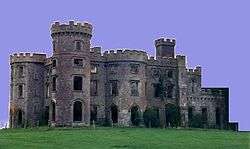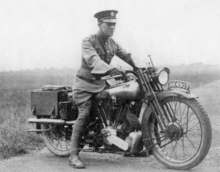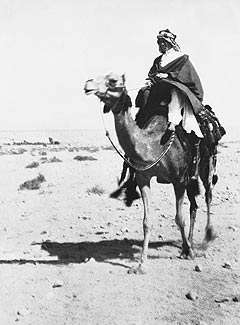Sir Thomas Chapman, 7th Baronet
| Sir Thomas Chapman | |
|---|---|
| Born | 6 November 1846 |
| Died | 8 April 1919 (aged 72) |
| Other names | Thomas Robert Lawrence |
| Title | Chapman Baronet |
| Predecessor | Sir Benjamin Rupert Chapman |
| Spouse(s) | Edith Sarah Hamilton |
| Partner(s) | Sarah Lawrence |
| Children |
Eva Jane Louisa Chapman (b. 1874) Rose Isabel Chapman (b. 1878) Florence Livia Chapman (b. 1880) Mabel Cecele Chapman (b. 1881) Montagu Robert Lawrence (b. 1885) Thomas Edward Lawrence (b. 1888) William George Lawrence (b. 1889) Frank Helier Lawrence (b. 1893) Arnold Walter Lawrence (b. 1900) |
| Parent(s) |
William Chapman Louisa Vansittart |

Sir Thomas Robert Tighe Chapman, 7th Baronet (6 November 1846 – 8 April 1919) was an Anglo-Irish landowner, the last of the Chapman baronets of Killua Castle in Ireland. For many years he lived under the name of Thomas Robert Lawrence, taking the name of his partner, Sarah Lawrence, the mother of his five sons, one of whom was T. E. Lawrence, 'Lawrence of Arabia'.[1]
Early life and background
Born in 1846, the second of the three sons of William Chapman (1811–1889) and his wife Louisa, daughter of Colonel Arthur Vansittart (1775–1829), of Shottesbrook, and the grandson of Sir Thomas Chapman, 2nd Baronet, Chapman was educated at Eton College.[2][3][4]
He was brought up to lead the life of a country gentleman, at a house called South Hill, near the village of Delvin, County Westmeath, Ireland, a modest property of some 170 acres, and also at the family's town house in Dublin. The Chapman family belonged to the higher level of the Anglo-Irish landowning class and for generations its members had married into families of a similar standing in England and Ireland.[3]
Debrett's Baronetage for 1918 says:
John Chapman, and his brother William, through the influence of Sir Walter Raleigh, their cousin-german, received large grants of land in Ireland, and settled in that country. Benjamin, the son of William Chapman, was an officer of cavalry in Cromwell's army, and for his services received the castle and estates of Killua, sometime the seat of the family. The 3rd baronet sat as M.P. for Westmeath ... Sir Benjamin James, 4th baronet, sat as M.P. for Westmeath... 1841–7 and was Lord-Lieutenant of that county. The 5th baronet, Sir Montagu Richard, was High Sheriff of County Westmeath.[5]
Life
As a younger son, it was expected that Chapman would run, rather than own, the family's estates, and from 1866 to 1868 he learnt about estate management at the Royal Agricultural College, Cirencester. However, his elder brother, William Eden Chapman (1844–1870), an officer in the 15th The King's Hussars, died in May 1870, leaving Chapman as the heir. The third brother, Francis Vansittart Chapman, was then trained to manage the estates.[3][6]
On 24 July 1873, Chapman married Edith Sarah Hamilton (b ca 1847), daughter of George Augustus Rochfort-Boyd, JP, DL, of Middleton Park, County Westmeath,[7] and they had four daughters, Eva Jane Louisa (born 1874), Rose Isabel (born 1878), Florence Livia (born 1880) and Mabel Cecele (born 1881).[2][3][8]
In the late 1870s, the Chapmans took on as a governess a capable and cheerful young Scotswoman who was known as Sarah Lawrence. By this time, Edith Chapman had become zealously religious, subjecting members of her household to frequent prayer meetings and disapproving of many of their pleasures, while Chapman himself had become a heavy drinker. He fell in love with Sarah Lawrence, who was younger than he by some fifteen years.[3] One of Chapman's daughters later recalled that her father usually had a dour manner, but whenever Sarah Lawrence entered a room, he became "all gay".[9] Lawrence, who had been born on 31 August 1861 in Sunderland, County Durham, had been registered at birth under the surname of her unmarried mother, Elizabeth Junner, who at the time was working as a servant in the house of Thomas Lawrence, a Lloyd's surveyor, and his son John Lawrence is thought to have been Sarah Lawrence's father.[3]
In 1885, Lawrence became pregnant. She went to live in rooms in Dublin which Chapman got for her, and in December 1885 a son was born and christened Montagu Robert. Chapman stayed with his wife, while seeing Lawrence and his son, until Edith Chapman found out what had happened (the Chapmans' butler, while in a Dublin grocer's shop, heard a young woman give her name as Mrs Thomas Chapman – he recognised the woman as Sarah Lawrence). He then left his wife to live with Lawrence. He took her to live at Tremadog, Caernarfonshire, now Gwynedd, North Wales, and their second illegitimate son, christened Thomas Edward and later known as Lawrence of Arabia, was born there in August 1888.[3]

'Lawrence of Arabia'
The couple stayed only a short time in Tremadog, and soon moved on, to Kirkcudbright in the Stewartry of Kirkcudbright in Scotland, then to Dinard in Brittany, the Isle of Wight, and the New Forest, choosing places where their English neighbours were not of Chapman's class and were unlikely to recognise him. They had nine children altogether, but three of them died young, leaving five sons and a daughter who survived infancy. In 1896, still unmarried and going under the name of Mr and Mrs Lawrence, the couple arrived in Polstead Road, Oxford.[10] The purpose of this move was largely to enable them to educate their sons, despite limited means.[3][11]
Chapman lived a life of leisure and spent much of his time with his sons. He was a photographer, hunted, spoke good French, was interested in medieval architecture, taught his sons carpentry, and even in old age would quote from Homer and Horace. He bought smart new bicycles and liked to cycle long distances.[12]
In 1914, Chapman succeeded his cousin Sir Benjamin Rupert Chapman, 6th Baronet (1865–1914), to the baronetcy.[2] When he died on 8 April 1919, he was buried at Wolvercote Cemetery.[13] As he left no legitimate male heirs, the title became extinct.[2]
Chapman's son T. E. Lawrence had already become world-famous, following the Arab Revolt of 1916. Another of his surviving sons, A.W. Lawrence (1900–1991) became notable as an archaeologist and art historian.[1]
Money affairs in exile
On 30 March 1888, Chapman assigned his life interest in his father's estates to his younger brother Francis Chapman, in exchange for an annuity for life of £200. Their father, William Chapman, died in 1889, leaving the bulk of his property to his son Francis. However, Chapman also had (or later inherited) some capital, which by 1916 was more than £20,000, producing at the time an annual income of some £1,000, a substantial figure.[3]
Chapman (otherwise Mr Lawrence) was probably disappointed when his brother Francis died unmarried in 1915, leaving him only £25,000 of his estate of £120,296, with £10,000 going to the Adelaide Hospital in Dublin and £25,000 being shared by Chapman's four daughters, who were also the residuary legatees. When Chapman (Lawrence) received the £25,000, he shared part of it out among his sons.[3]
Chapman had a sister, Caroline Margaret Chapman, who in 1894 married her cousin, Montagu Chapman, later the fifth Chapman baronet, and Sir Montagu died childless in 1907.[8] In 1911, his widow made a Will which divided the Killua estate, leaving £20,000 to her brother, Chapman, and separate large amounts to his four daughters. However, when she died in 1920, the £20,000 went to the daughters, as her residuary legatees, as Chapman had himself died a few months before and she had not specified that the bequest was to go elsewhere in that event. The loss of the £20,000 may explain the bitterness of an allusion to the Chapmans which T. E. Lawrence added to Liddell Hart's biography of him: "The father's family seemed unconscious of his sons, even when after his death recognition of their achievement might have done honour to the name."[3]
What was left of the family's land in Ireland was sold in 1949 and then came to some 1,230 acres (5.0 km2).[3]
Descendants
Chapman had four daughters: Eva Jane Louisa (b. 1874); Rose Isabel (b. 1878); Florence Lina (b. 1880) and Mabel Cecele (b. 1881).
Chapman's eldest son Montagu Robert Lawrence (1885–1971) became a physician and was a medical missionary in China.[14]
His second son Thomas Edward Lawrence died childless in a motorcycle accident in 1935, while his third and fourth sons, William George Lawrence (1889–1915)[15] and Frank Helier Lawrence (1893–1915),[16] also childless, were killed during the First World War.[6]
His fifth son, Arnold Walter Lawrence (1900–1991), married Barbara Thompson in 1925 and had one child, Jane Helen Thera Lawrence (1926–1977).[6] In 1947, she married James Macdonald Cassels[17] (1924–1994), who became Lyon Jones Professor of Physics in the University of Liverpool in 1960, and they had two children, Alistair Lawrence Cassels (1952) and Suzanna Kennedy Cassels (1958).[18][19][20]
Sarah Lawrence died in 1959, aged 98, in an Oxford nursing home.
Notes
- 1 2 Lawrence, Arnold Walter at dictionaryofarthistorians.org, accessed 17 August 2008
- 1 2 3 4 'CHAPMAN, Sir Thomas Robert Tighe', in Who Was Who, A & C Black, 1920–2007; online edition by Oxford University Press, December 2007 (subscription required) CHAPMAN, Sir Thomas Robert Tighe, accessed 16 August 2008
- 1 2 3 4 5 6 7 8 9 10 11 12 Wilson, Jeremy, T. E. Lawrence: family history at telawrence.info, accessed 16 August 2008
- ↑ Arthur Vansittart at geneall.net, accessed 17 August 2008
- ↑ Debrett's Illustrated Baronetage (London: Debrett, 1918) p. 135
- 1 2 3 T. E. Lawrence's Family Tree at homepage3.nifty.com, accessed 25 August 2008
- ↑ George Augustus Rochfort-Boyd was the son of Jane (nee Mackay), Countess of Belvedere (widow of the 2nd and last Earl; she died 1836) by her 2nd husband. The 2nd Earl of Belvedere (d 1814) left his unsettled (unentailed) estates to his widow, not his nephew the 3rd Earl of Lanesborough or a younger nephew. Jane, Countess of Belvedere, now a great Irish heiress, married her first husband's barrister Abraham Boyd KC (1760–1822)in December 1815, and had an only son who inherited the estates on her death 1836. The son changed his name by Royal License 16 November 1867 from George Augustus Boyd to George Augustus Rochfort-Boyd.
- 1 2 Ruvigny & Raineval, Marquis of, The Plantagenet Roll of the Blood Royal, Mortimer-Percy Volume, p. 278 online at books.google.co.uk, accessed 25 August 2008
- ↑ Florence, Ronald, Lawrence and Aaronsohn: T.E. Lawrence, Aaron Aaronsohn, and the Seeds of the Arab-Israeli Conflict (Viking, 2007, ISBN 978-0-670-06351-2) p. 54
- ↑ Florence, op. cit., p. 55
- ↑ Mack, John E., A Prince of Our Disorder: The Life of T. E. Lawrence (Boston: Little, Brown, 1976, ISBN 0-316-54232-6)
- ↑ Florence, op. cit., p. 56
- ↑ Sir Thomas Robert Tighe Chapman at findagrave.com, accessed 17 August 2008
- ↑ Wearing, J. P. (ed.), Bernard Shaw and Nancy Astor (University of Toronto Press, 2005, ISBN 978-0-8020-3752-7) pp. 58–59 (letter from George Bernard Shaw to Nancy Astor dated 21 March 1933)
- ↑ CWGC entry for Second Lieutenant William George Lawrence
- ↑ CWGC entry for Second Lieutenant Frank Helier Lawrence
- ↑ Holt, J. R. (1996). "James MacDonald Cassels. 9 September 1924-19 October 1994". Biographical Memoirs of Fellows of the Royal Society. 42: 62–26. doi:10.1098/rsbm.1996.0005.
- ↑ Cassels, Prof. James Macdonald in Who Was Who, A & C Black, 1920–2007, online edition by Oxford University Press December 2007 (subscription required)
- ↑ Family of James MacDonald Cassels and Jane Helen Thera Lawrence
- ↑ Descendants of Thomas Thompson - RogerThompson.com - Family Tree
| Baronetage of the United Kingdom | ||
|---|---|---|
| Preceded by Benjamin Chapman |
Baronet (of Killua Castle) 1914–1919 |
Succeeded by Extinct |
